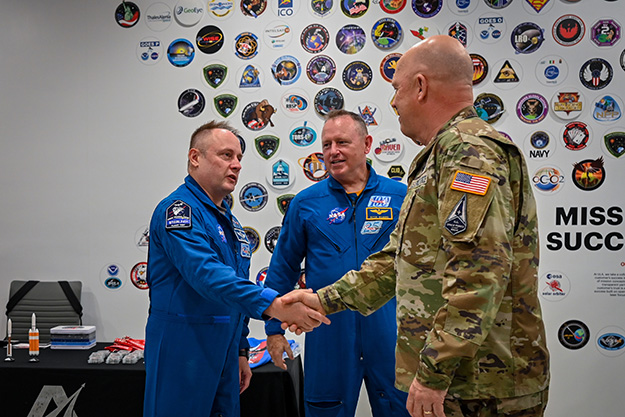Space Force Gen. John W. "Jay" Raymond made the announcement at the Air Force Association meeting in Washington, Sept. 22. The transfers are scheduled to be effective Oct. 1, 2021, if the DOD budget is passed and signed.
"We're one team with our sister services and over the last year-and-a-half we have worked with the Army and the Navy and the Air Force to determine which capabilities come over to the Space Force," Raymond said. "The intent was to consolidate (and) increase our operational capability; increase our readiness and do so in a more efficient manner."
The changes are "a first tranche," he said.
This is the latest step in building the new service. The idea behind the U.S. Space Force was "to create a unity of effort around our space enterprise," said Space Force Lt. Gen. B. Chance Saltzman, the service's deputy chief of space operations for operations, cyber and nuclear. Simply forming the service made the idea of looking for efficiencies possible.
"We need to create this unity of effort around our space missions, to ensure we're up to those challenges that we face, because the space domain has rapidly become far more congested, and far more contested than ... when I was a lieutenant or a captain operating space capabilities," Saltzman said.
The performance of satellite communications will be enhanced by this sort of unity of effort.
On the Navy side, the Navy's narrow band satellite constellation will transfer 76 manpower authorizations to the Space Force, as well as 13 satellites - a mix of the new multi-user objective system and the UHF follow-on satellite constellation.
The U.S. Army will transfer roughly $78 million of operations, maintenance and manpower authorizations. This will include five wideband SATCOM operations centers, and four regional SATCOM support centers. This will affect about 500 manpower authorizations.
All told, 15 global units with 319 military and 259 civilian billets from the Army and Navy combined will transfer to the Space Force.
These are crucial defense capabilities. The units can't stop just because the function is transferring to the Space Force. The capabilities are needed 24/7 and they will be, Saltzman said.
The move puts basically all of the DOD's narrowband, wideband and protected SATCOM under control of U.S. Space Force. "Now all of that - training, operations, acquisition and sustainment and follow-on activities, user allocations - all of that, will be consolidated under the Space Force to create that unity of effort, and hopefully gain the ability to be more resilient, more dynamic, and ultimately more efficient with that mission set," Saltzman said.
The soldiers, sailors and Army and Navy civilians are not obligated to move to Space Force. There is a process and those involved must volunteer to move. For civilians, the process is relatively easy - simply moving from an Army or Navy system to becoming Department of the Air Force employees. For soldiers and sailors, this requires release by their respective services and acceptance by the Space Force.





Read Comments